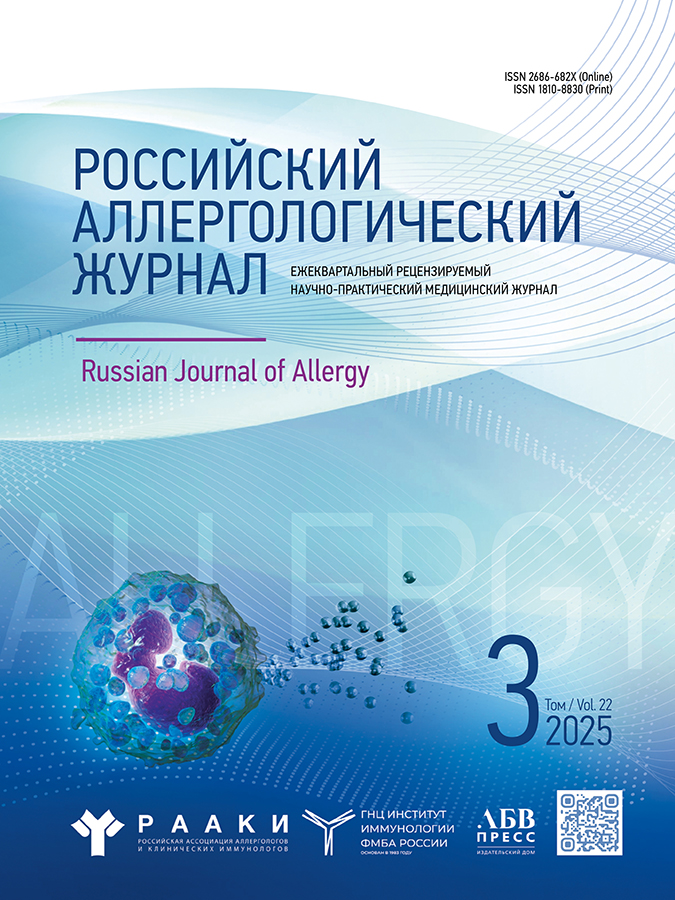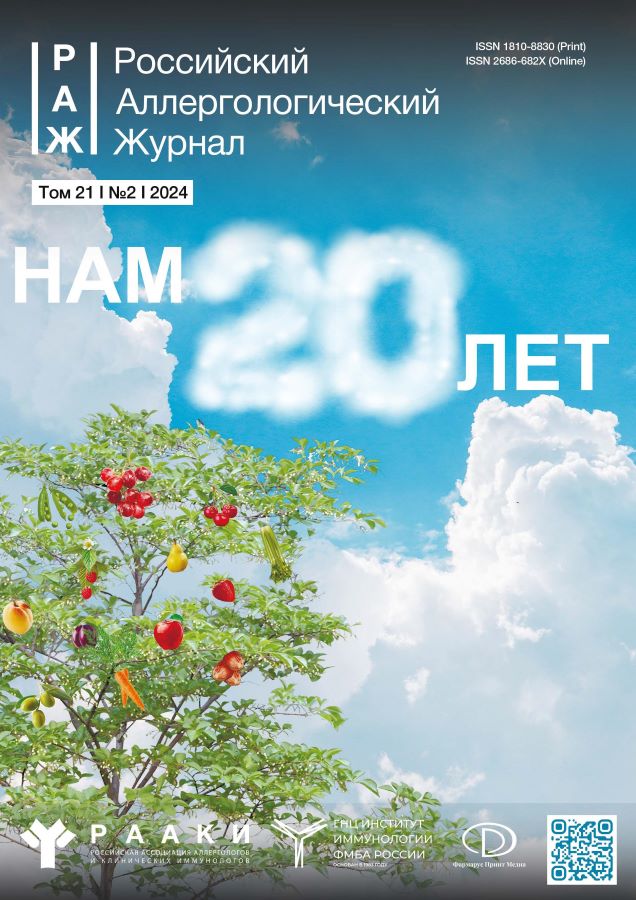Activated zinc pyrithione in topical treatment of atopic dermatitis: a case report
- Authors: Litovkina A.O.1,2, Smolnikov E.V.1,2,3, Elisyutina O.G.1,2, Fedenko E.S.1
-
Affiliations:
- National Research Center-Institute of Immunology Federal Medical-Biological Agency of Russia
- Peoples' Friendship University of Russia
- National Research Nuclear University MEPhI (Moscow Engineering Physics Institute)
- Issue: Vol 21, No 2 (2024)
- Pages: 305-312
- Section: Case reports
- Submitted: 08.05.2024
- Accepted: 21.05.2024
- Published: 16.06.2024
- URL: https://rusalljournal.ru/raj/article/view/16947
- DOI: https://doi.org/10.36691/RJA16947
- ID: 16947
Cite item
Abstract
Atopic dermatitis is a systemic multifactorial genetically determined inflammatory skin condition characterized by an impairment of the epidermal barrier and Type 2 inflammation. Atopic dermatitis is highly prevalent, especially among children. Many authors consider atopic dermatitis as the initial stage of the atopic march, which typically manifests in the first year of life. Topical agents such as topical glucocorticosteroids and topical calcineurin inhibitors are the first-line treatments for atopic dermatitis. In recent years, there has been an increasing use of modern systemic anti-inflammatory agents, such as monoclonal antibodies and Janus kinase inhibitors.
Therapy of patients with atopic dermatitis is aimed at relieving itching, improving skin barrier function, reducing inflammation, preventing skin infection and exacerbations. The effectiveness of treatment lies not only in improving the symptoms and quality of life of patients with atopic dermatitis, but also in preventing them from developing chronic or severe symptoms.
Modern topical glucocorticosteroids and their combinations, have a proven high safety profile. However, available data on adverse events associated with their use often lead patients and their parents to develop a negative, phobic attitude towards treatment with these drugs. Zinc pyrithione, an activated form of zinc, is a safe and highly effective medication with anti-inflammatory, antifungal, and antibacterial properties.
This article presents two clinical cases of moderate to severe atopic dermatitis in children, demonstrating the effectiveness of using activated zinc pyrithione in comprehensive therapy for this condition.
Full Text
About the authors
Alla O. Litovkina
National Research Center-Institute of Immunology Federal Medical-Biological Agency of Russia; Peoples' Friendship University of Russia
Author for correspondence.
Email: dr.litovkina@gmail.com
ORCID iD: 0000-0002-5021-9276
SPIN-code: 2337-7930
MD
Россия, Moscow; MoscowEvgeniy V. Smolnikov
National Research Center-Institute of Immunology Federal Medical-Biological Agency of Russia; Peoples' Friendship University of Russia; National Research Nuclear University MEPhI (Moscow Engineering Physics Institute)
Email: qwertil2010@yandex.ru
ORCID iD: 0000-0003-1302-4178
SPIN-code: 4874-8100
MD
Россия, Moscow; Moscow; MoscowOlga G. Elisyutina
National Research Center-Institute of Immunology Federal Medical-Biological Agency of Russia; Peoples' Friendship University of Russia
Email: el-olga@yandex.ru
ORCID iD: 0000-0002-4609-2591
SPIN-code: 9567-1894
MD, Dr. Sci. (Med.)
Россия, Moscow; MoscowElena S. Fedenko
National Research Center-Institute of Immunology Federal Medical-Biological Agency of Russia
Email: efedks@gmail.com
ORCID iD: 0000-0003-3358-5087
SPIN-code: 5012-7242
MD, Dr. Sci. (Med.), Professor
Россия, MoscowReferences
- Kubanov AA, Namazova-Baranova LS, Khaitov RM, et al. Atopic dermatitis. Russ J Allergy. 2021;18(3):44–92. EDN: UXCPWL doi: 10.36691/RJA1474
- Wollenberg A, Christen-Zäch S, Taieb A, et al. ETFAD/EADV eczema task force 2020 position paper on diagnosis and treatment of atopic dermatitis in adults and children. J Eur Acad Dermatol Venereol. 2020;34(12):2717–2744. EDN: CWTNIS doi: 10.1111/jdv.16892
- Wollenberg A, Kinberger M, Arents B, et al. European guideline (EuroGuiDerm) on atopic eczema: Part I: Systemic therapy. J Eur Acad Dermatol Venereol. 2022;36(9):1409–1431. EDN: HYTUSX doi: 10.1111/jdv.18345
- Smith SD, Hong E, Fearns S, et al. Corticosteroid phobia and other confounders in the treatment of childhood atopic dermatitis explored using parent focus groups. Australas J Dermatol. 2010;51(3):168–174. doi: 10.1111/j.1440-0960.2010.00636.x
- Albogami MF, Al Jomaie MS, Almarri SS, et al. Topical corticosteroid phobia among parents of children with atopic dermatitis (eczema): A cross-sectional study. Patient Prefer Adherence. 2023;(17):2761–2772. doi: 10.2147/PPA.S431719
- El Hachem M, Gesualdo F, Ricci G, et al. Topical corticosteroid phobia in parents of pediatric patients with atopic dermatitis: A multicentre survey. Ital J Pediatr. 2017;43(1):22. EDN: YBYSDG doi: 10.1186/s13052-017-0330-7
- Ohtsuki M, Morimoto H, Nakagawa H. Tacrolimus ointment for the treatment of adult and pediatric atopic dermatitis: Review on safety and benefits. J Dermatol. 2018;45(8):936–942. doi: 10.1111/1346-8138.14501
- Rowlands CG, Danby FW. Histopathology of psoriasis treated with zinc pyrithione. Am J Dermatopathol. 2000;22(3):272–276. EDN: LOUQFX doi: 10.1097/00000372-200006000-00013
- Nenoff P, Haustein UF. [Effect of anti-seborrhea substances against Pityrosporum ovale in vitro. (In German)]. Hautarzt. 1994;45(7):464–467. doi: 10.1007/s001050050105
- Mokronosova MA, Maksimova AE, Baturo AP, Kataeva OV. The effect of various topical therapy on the skin colonization of S. aureus and the course of atopic dermatitis. Russ J Allergy. 2004;(1):58–61. EDN: TKAMFD
Supplementary files






